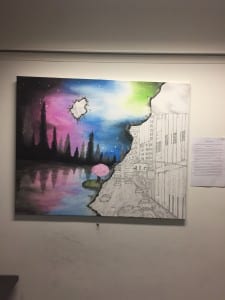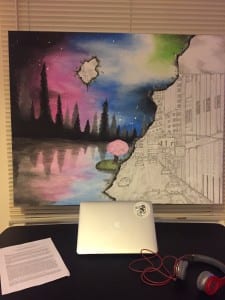In the audio part of the project, the most important, I didn’t have a set plan for how it would go or what it would sound like at the end, just a general idea. I knew it would have a space feel to it, because of the use of synthesizers, and I knew there would be hard hits in there from recordings from around the city. The piece starts completely futuristic, and eerie, and the urban recordings come in to the composition gradually; there is no massive build up in this piece, it is very gradual and even though there are points where it may sound like there will be a drop, there really isn’t. This was not something done by accident, or from a lack of imagination either, because I feel this reflects the visual piece; the more dominant being the painting that represents the synths, and although it is breaking apart in areas and the sketch is coming through, representing the recordings, it never fully takes over. There are some sounds that you hear that are obvious they are recordings, such as the water dripping and the saw sound at the end, some sounds that you may question, like the low bass rumble you hear that kicks in half way through being from a construction site, and the there are some that I have manipulated in the piece where you may not take a second thought as to whether they’re recordings or not, for example the distorted, slightly white noise you hear is in fact a recording of a train leaving the station; from that same recording I have left the steam from the train as it was without being touched, which appears every now and then in the audio. I never experienced any problems with managing my time in this project, even when I lost my composition at 1 minute in and had to redo it, and with the creating the art piece as well, because time management is something I personally am good at in general; this is why I wasn’t afraid to take on a large painting/sketch along with a long composition.
For my own personal aims and objectives, I see myself as completing all of them: before this I had been apart of a group doing field recordings, and after it I couldn’t really explain what happened, so for this project I made it a priority to incorporate field recordings into the composition and I myself will retrieve the recordings using equipment I have never used before, because I wanted to challenge myself. After using The Marantz recording kit, I now have a lot of confidence for using it and other zoom mics in the future; not only for the technology side of it, but also realising that when walking around with the mic in my hand it seemed as though more sounds were jumping out at me and I was thinking about what I could do with the sounds before even putting them into my project. I first started off using Logic years ago and it was always my more preferred piece of software, but being at university pretty much everything is done on Pro Tools, so I lost touch with Logic, this is why becoming re-acquainted with it was a necessity to me and why I chose this software. Gaining knowledge on the history and conducting research was not only a requirement on the list for this project for everyone, but for my chosen project I felt it was very important; experimental music, something that isn’t mainstream and known to everyone, needs an explanation of the history – where it started, what’s been done since and what’s happening today. I have done, I feel, an extensive amount of research not only on the history of how experimental music came about – through the likes of John Cage and Pierre Schaeffer – but also pieces written but those that are passionate about the joining of audio and visual – such as The Noises of Art conference – and other work and exhibitions that show the importance of this joining of different art forms, like how they did at The National Gallery in London with the likes of composers and DJ’s creating audio pieces to accompany visual art pieces. Another part of this project was having our work reach the public, and although this has not happened yet it will be happening as part of an exhibition that will be taking place next year, this is why I displayed my work as it would be when it will be in the exhibition, as follows:
The most difficult thing I found in this project was trying to get my work out there, whether that be online or as part of an exhibition, and this is I feel because of the combination between audio and visual not being something you come across all the time, and if it wasn’t for Emily being part of the ESP group then I would have chosen to set up the project somewhere on university campus, with headphones and the description next to the art piece for anyone to listen to. Although I see that I could have involved more recorded sounds into the piece, I am happy with the sounds I did record, and that I have used one recording a couple of times in different ways to the point where you would think they were separate recordings, and as I have previously stated, the synths being slightly more dominant reflects my message and my art piece. In reflection of my audio project I am really happy with the outcome and the steps I took to get there; not only is my art piece what I pictured it to be at the beginning in the ideas stage, but my audio piece I feel has achieved what I wanted it to and it reflects the message I put forward, and I am happy with me newly gained knowledge on experimental music and seeing that there has been a lot of work into the combination of different art platforms, getting rid of the boundaries between them.

